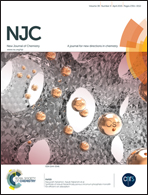A pyrene based Schiff base probe for selective fluorescence turn-on detection of Hg2+ ions with live cell application†
Abstract
A novel pyrene based free thiol containing a Schiff base derivative PT1 was synthesized via a one-pot reaction and utilized as a fluorescence turn-on probe for Hg2+ ion detection along with live cell imaging. PT1 in DMSO/H2O (v/v = 7/3; pH 7.0) showed fluorescence turn-on response to Hg2+ ions, via chelation enhanced fluorescence (CHEF) through excimer PT1-PT1* formation. The 2 : 1 stoichiometry of the sensor complex PT1 + Hg2+ was calculated from the Job plot based on UV-Vis absorption titrations. In addition, the binding sites of the sensor complex PT1 + Hg2+ were well established from the 1H NMR titrations and were supported by the ESI-mass analysis and fluorescence reversibility of PT1 + Hg2+via the consequent addition of Hg2+ ions and EDTA. The detection limit (LOD) and the association constant (Ka) values of the PT1 + Hg2+ complex were calculated by standard deviation and linear fittings and from the Benesi–Hildebrand plot, respectively. Moreover, the quantum yield (Φ), time resolved photoluminescence (TRPL) decay constant (τ) changes, pH effect and density functional theory (DFT) studies were investigated for the PT1 + Hg2+ sensor system. More importantly, confocal fluorescence microscopy imaging in Hela cells showed that PT1 could be used as an effective fluorescent probe for detecting Hg2+ in living cells.


 Please wait while we load your content...
Please wait while we load your content...